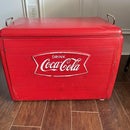Introduction: 3-D Vertical Chess
I have to give credit for the vertical chess idea to "brooklyntonia" and dave.vaness.79, both of whom inspired me to build my own board, so you may want to check out their instructables as well.
First of all, I had some large chess pieces and no place to leave the chess board when half way through a game, so a vertical chess board that hangs on the wall makes perfect sense. Playing in this orientation takes some getting used to due to the steep diagonals and the fact that if you are the player whose pieces are at the top of the board, you need to reverse your thinking. To me, that just adds more challenge to an already challenging game.
The 3-D effect comes from the fact that the white tiles stick out farther than the blue ones. (Why blue? I had the paint already) Also, since the blue, or dark colour is the background, you only have to make 32 tiles, saving work. Also, since all chess sets are different sizes, I give instructions for sizing the board to your specific chess pieces.
Step 1: Tiles and Shelves
You need to make 32 white tiles. My largest chess piece,(the King) is 3,3/4" so I added 3/8" to give some movement room as the pieces sit on shelves and must have clearance to be removed and replaced. I also added another 1/4" as that is the thickness of the shelves and I install the tiles with 1/4" overlap to allow a glueing surface for the shelf edges. That makes each tile 4,3/8".
Tiles are made from 1,1/2" x 1/2" Primed MDF available in 8 foot lengths in the moulding section of building stores. I used two 8 foot pieces. Home Depot SKU# 15002-96096C.
It is imperative to cut these accurately so I used a power mitre saw set to 4,3/8". I primed the cut ends and sprayed each tile with white semi gloss paint. I also made a score mark 1/4" from the edge of each to assist in lining them up in final assembly.
You need 7 shelves, each 12" long. Again, be accurate with the cuts as you don't want them to be too tight or too loose, leaving gaps.Use a mitre saw.
Shelves are made from white plastic lattice 1,1/2" x1/4". I used one 8 foot length. Again it is from the moulding section. Home Depot SKU#08015-2W096CB
Step 2: Shadow Box
You need to make a shadow box to enclose the white tiles and provide a background colour for the dark tiles. I ripped some pine to 2,1/4". This allows the 1/2" tiles and the 1,1/2" shelves to fit with a 1/4" recess at the front edges.
Inside width of the box is 12". Height is dependent on the length of your tiles before you add the 1/4" overlap. Mine were 4,1/8". Multiply that by 8 (the number of playing spaces) and that gives an inside length of 33".
Remember, those are inside dimensions so cut your frame pieces accordingly. I used construction adhesive and brad nails to hold mine together, I cut a piece of 1/8" primed hardboard for the backing and attached it the same way, squaring it up before doing so.
Finally, I filled, sanded, primed and painted the box
Step 3: Install the Tiles
Start in the bottom right corner with a white tile. Cardinal rule of chess: White=Right. In other words the white or light colour square must be at each player's right. Put all the tiles in the box without glue to make sure they line up properly. Stagger them 1/4" using a tile as a spacer and the score marks as a guide. When satisfied, glue them in place with construction adhesive. I used "No More Nails". Just small dabs, you don't want any squeeze out. If it happens, use a Q-Tip to clean it up. Let the glue dry.
Step 4: Install Shelves
For this I used "GE Clear Silicone". It comes in a small tube and is easy to control. If you spill any you'll hardly notice as it is clear. Apply it sparingly to the 1/4" overlaps and up each side at the overlap line. Press the shelf in place till it adheres, making sure it is at 90 degrees to the tiles. Again, clean up any squeeze out with Q-Tips.Tape each top edge to the sides.. Once all 7 are in place, let them dry overnight.
To hang your game, measure about 6' from the top. Drill into the solid edges on the back side. Install anchors and screws into your wall and hang the game from them. Just be certain the screw heads fit into the holes you drilled.
Set up your board and play.







![Tim's Mechanical Spider Leg [LU9685-20CU]](https://content.instructables.com/FFB/5R4I/LVKZ6G6R/FFB5R4ILVKZ6G6R.png?auto=webp&crop=1.2%3A1&frame=1&width=306)





